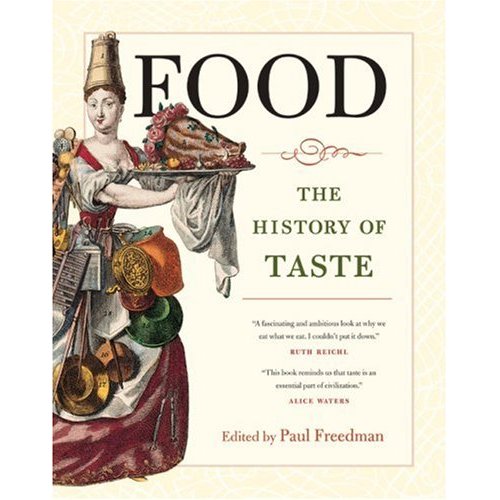MARIANI’S
November 25, 2007
NEWSLETTER
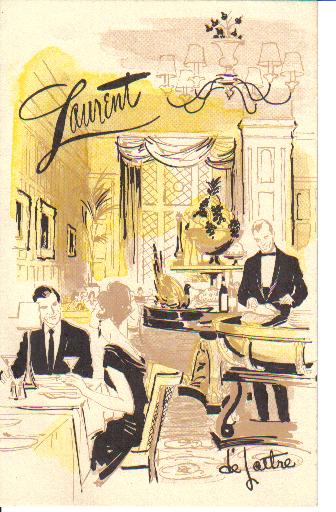
Menu Cover for Laurent restaurant, NYC, circa 1967
NEW! Click esquire.com
to go to my new biweekly column at Esquire
Magazine.
ARCHIVE: Readers may now access
an
Archive of all past newsletters--each annotated--dating back to July,
2003, by simply clicking on www.johnmariani.com/archive
SUBSCRIBE AND
UN-SUBSCRIBE: You may subscribe anyone you wish
to this newsletter--free of charge--by
clicking here.
In
This Issue
MICHELIN GUIDES TO L.A AND LAS VEGAS STIR CONTROVERSY by John Mariani
NEW YORK CORNER: BLT MARKET by John Mariani
NOTES FROM THE WINE CELLAR: Too Much Choice Makes
QUICK BYTES
BOOKS FOR HOLIDAY GIVING AND KEEPING
by John Mariani
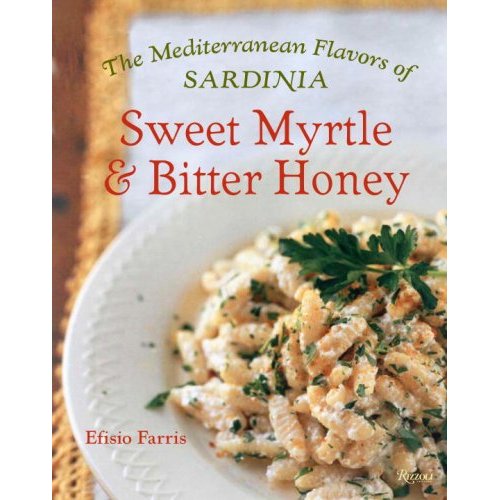
Sweet Myrtle & Bitter Honey by Efisio Farris (Rizzoli, $39.95)—Little has been written about the cuisine of
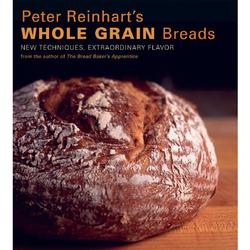
Peter Reinhart’s Whole Grain Breads by Peter Reinhart (Ten Speed Press, $35)—Once upon a time whole grain breads were what people ate if they couldn’t afford white bread, and most of them tasted like sawdust. But Reinhart, a baking instructor at Johnson & Wales University, shows by precise technique and incisive notes on ingredients why this need not be so and how whole grain breads actually have the most flavor of any breads and a great deal of healthfulness. There is old-fashioned Bavarian pumpernickel here, along with steamed Boston brown bread and even Graham crackers. There are no shortcuts here, however, so make sure you know what you’re getting into.
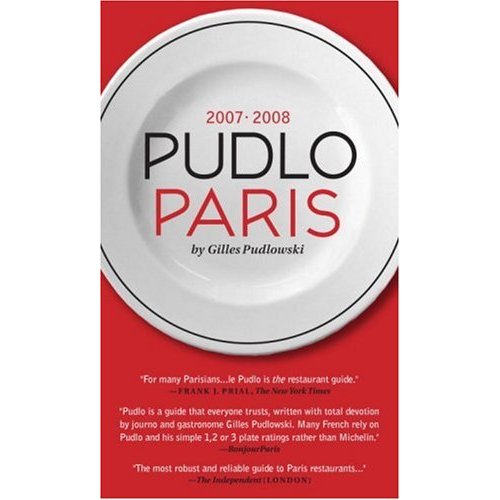
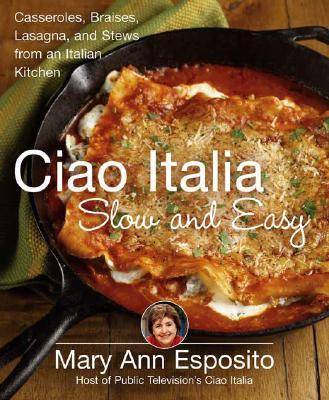
Ciao Italia Slow and Easy by Mary Ann Esposito (St. Martin's Press, $27.95)--Just look at that cover photo: One glance and you get hungry, and this delightful, honest, authentic book of Italian cookery is filled with dishes that are definite crowd-pleasers, from lentils and leeks with sausage and chicken and a fontina cheese casserole to Neapolitan stuffed red Bell peppers and apple bread pudding with caramel sauce. And it is all presented with the same gusto Mary Ann Esposito has been exuding on her PBS-TV show "Ciao Italia" for 18 years. There could be no better teacher than she for this kind of casalinga-style cookery, and this book (her ninth) shows how much she wants her readers and viewers to eat well and with passion.
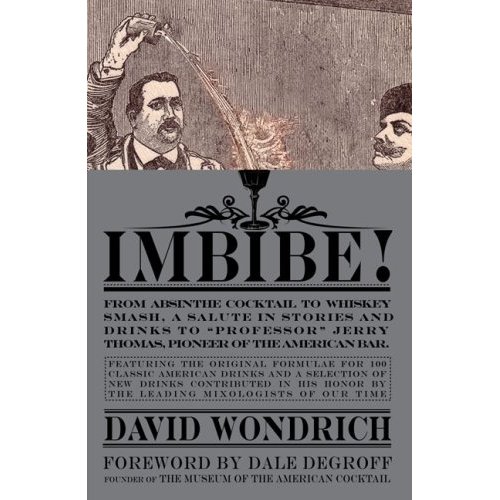
Imbibe! by David Woodrich (Perigee, $23.95). The subtitle says it all: "From Absinthe Cocktail to Whiskey Smash, a Salute in Stories and Drinks to `Professor' Jerry Thomas, Pioneer of the American Bar." Woodrich, who is spirits and drinks columnist for Esquire, provides not only recipes for 100 classic American cocktails but delves into the myth and truth of the famous 19th Century mixologist, along with plenty of fascinating details about the origins of cocktails, all engagingly written.
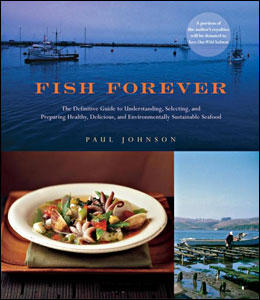
Fish Forever by Paul Johnson (Wiley, $35)—“The Definitive Guide to Understanding, Selecting, and Preparing Healthy, Delicious, and Environmentally Sustainable Seafood” is a lot for one 438-page book to accomplish, even for the owner of the Monterey Fish Market. (A portion of book sales goes to something called “Save Our Salmon.") Any book that brings common sense to the way seafood is fished—and over-fished—and the species we buy without much thought to their being endangered or perhaps endangering our own health with mercury levels is a book everyone who truly loves seafood should have. Add in nearly 100 recipes, and it becomes a keeper.

Secret Ingredients: The New Yorker Book of Food and Drink Edited by David Remnick (Random House, $29.95)--Couldn't they have come up with a better title for such a colorful collection of food and drink articles from decades of The New Yorker's vault by writers as disparate as Joseph Mitchell ("All You Can Eat for Five Bucks"), Anthony Lane ("Look Back in Hunger"), Calvin Trillin ("The Magic Bagel"), and John Cheever ("The Sorrows of Gin")? Terrific writing, often hilarious, always insightful, and, yes, there are a few scattered food-related cartoons including the original "I say it's spinach and I say the hell with it."
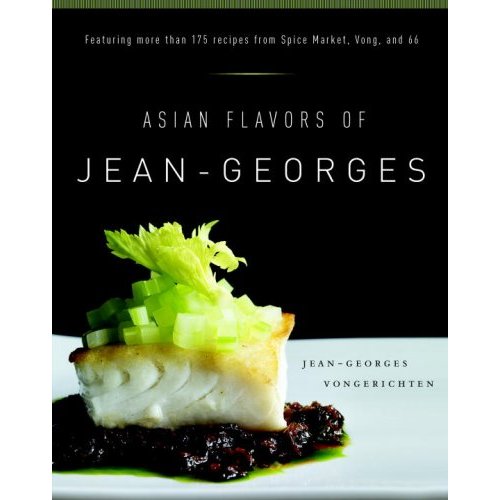
Asian Flavors of Jean-Georges by Jean-Georges Vongerichten (Broadway, $40)—The master of modern global cuisine, Alsatian-born Vongerichten was trained as a dyed-in-the-wool French classicist but found that he preferred to eat the kitchen worker’s grub when he worked at an haute cuisine restaurant in Bangkok. Those memories infuse his food to this day, and this collection of 175 recipes shows how to reproduce them with amazing style and grace. This is not just a professional chef's inspirational manual but a book the studious home cook can successfully manage.
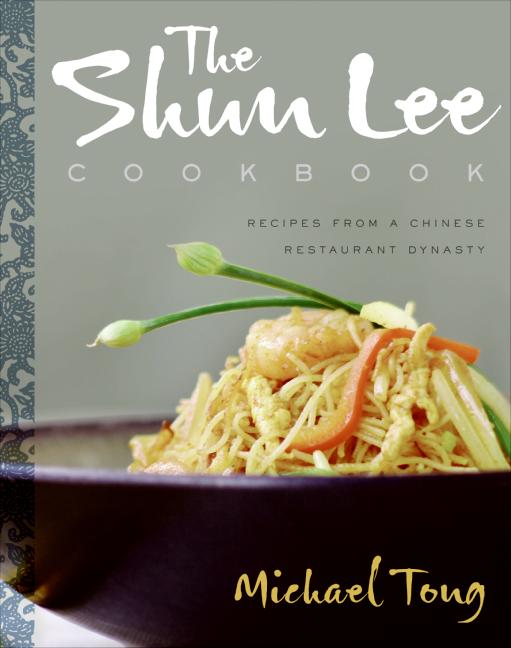
The Shun Lee Cookbook: Recipes from a Chinese Restaurant Dynasty by Michael Tong (Morrow, $29.95)--It may well be argued that Michael Tong almost singlehandedly, brought Chinese food out of the egg foo yung era forty years ago and even transcended the fad for super-hot Sichuan and Hunan food by maintaining his Shun Lee restaurants in New York as exemplars of refinement that demonstrated the glorious range of so many regional Chinese cuisines. Many of the best dishes of his cooks are here, from hot and sour cabbage and red-cooked chicken to "ants climbing a tree" and "Buddha's Delight." Amply illustrated with delectable photos, the recipes are well written and show you need not spend an inordinate amount of time hanging over a hot wok.
Food: The History of Taste,
Edited by Paul Freedman (
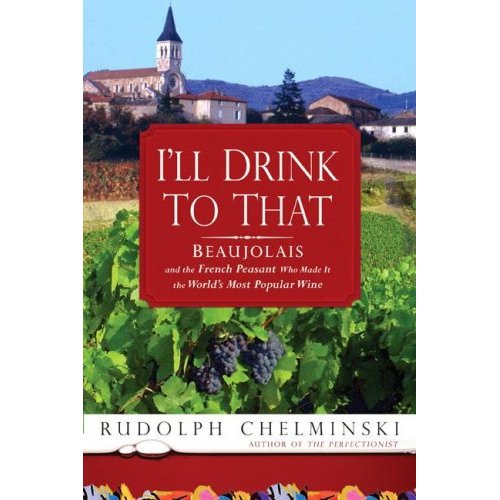
I'll Drink to That: Beaujolais and the French Peasant Who Made It the World's Most Popular Wine by Rudolph Chelmensky (Gotham, $27.50)--A rollicking tale well told of how Beaujolais conquered France, then achieved international popularity on the back of its least interesting bottling--Beaujolais Nouveau--a fad whose fading caused better Beaujolais to lose their luster. Chelminsky is a true Francophile in the best sense, and he tells the history of the terroir and of the business, which the redoubtable Georges DuBoeuf turned into a gold mine, with enormous affection for the old ways and the hard work that Beaujolais farmers have put in over a millennium to make good wine and eke out a living. Despite its dopey title, this is one of the best books ever written about wine.
Mouth
Wide Open: A Cook and His Appetite by John Thorne with Matt
Lewis Thorne (North
Point Press. $26)--As John Thorne explains in his intro, he has little
interest
in recipes unless they are historical and have "the potential for a
lively
conversation." That is the tone of this wonderful collection of
Thorniana, from his fascinating essays on everything from Pepper Hot
Pot and Bagna
Caôda to Eggs Florentine and Swedish Meatballs. His writing
is deceptively
simple, beautifully cadenced, very much a conversation with a
likeminded reader.
Most are taken from Thorne's long-running newsletter Simple Cooking,
but
they seem as fresh and timeless as a simmering minestrone, about which
he
writes an extensive, lovely essay.
~~~~~~~~~~~~~~~~~~~~~~~~~~~~~~~~~~~~
NEW MICHELIN GUIDES FOR LAS VEGAS AND L.A. by John Mariani

The reason, which I asked Naret (below) about in a radio interview, was that Michelin already had its five inspectors in place in to do the L.A. guide, so they could be pressed into double duty (they must be eating as fast as they can!) to hop over to Vegas to research that city too. Fair enough, I suppose, although there is no contextual mention in the L.V. guide as to its relative and relevant ranking among other, much stronger U.S. restaurant cities. As I indicated during the interview, and as reiterated on air by John A. Curtas, restaurant critic for Nevada Public Radio and KLAS-TV and reporter on Vegas for the Virtual Gourmet, the city still lacks the kind of neighborhood, freestanding restaurants that it needs to be called a great food city. Curtas also noted that it lacks the markets and local provender other cities have access to; indeed, if Fed-Ex did not exist, L.V. wouldn't have many restaurants.
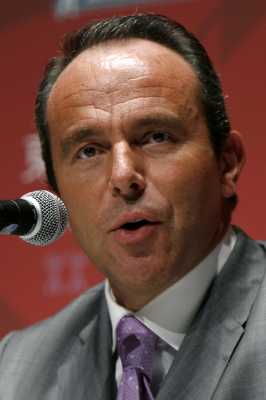 Naret said that, unlike in Europe where a restaurant
might
be judged by a single visit by a single inspector dining alone (for a
report on Michelin inspectors' modus operandi, click
here),
in L.A. and L.V. inspectors may dine with others because, "In Europe
it is not unusual for a person to dine in a fine restaurant alone, but
it would be suspect in the U.S." Again, fair enough, although it is
well known that European
restaurateurs get very suspicious
about solo diners and pass the word
around town that there may be a Michelin man in their midst.
Naret said that, unlike in Europe where a restaurant
might
be judged by a single visit by a single inspector dining alone (for a
report on Michelin inspectors' modus operandi, click
here),
in L.A. and L.V. inspectors may dine with others because, "In Europe
it is not unusual for a person to dine in a fine restaurant alone, but
it would be suspect in the U.S." Again, fair enough, although it is
well known that European
restaurateurs get very suspicious
about solo diners and pass the word
around town that there may be a Michelin man in their midst.So what are the results of Michelin's findings in L.V. and L.A.? Quite a few surprises and quite a few obvious choices. In L.V. Joël Robuchon gets three stars; Alex, Guy Savoy, and Picasso get two; and a dozen get one. I wouldn't quibble much about any of those ratings except to say that of the 16 starred restaurants, nine are--guess what!-- dyed-in-the-wool French. Naret's response on air was that "We couldn't care less if The French Laundry [in Napa Valley] was called The Spanish Laundry as long as the food is superior." But, of course, the French Laundry (which got its name from a former laundry on its premises) is a French restaurant, and so is Picasso (though the chef, Julian Serrano, is Spanish), and so is Alex (though Alessandro Stratta is American).
As stated again and again, Michelin contends they judge only what's on the plate, not the décor. That is a little hard to believe when almost every restaurant with a star is a very big deal, very elaborate, very pricey restaurant. (Ask any restaurateur in France what he thinks it costs to win a Michelin star, and the figure starts at about 3 million euros for décor and amenities alone; Michelin denies that has any bearing on its ratings.) I also bristle when Michelin insists it couldn't care less if the chef whose name is on the door is ever actually in the kitchen. Thus, whether or not Robuchon or Guy Savoy or Alain Ducasse (his mIX [sic] got one star) or Michael Mina (one star) is in the kitchen, Michelin is assuring us that all will be exactly the same as if they were--a contention that gets a big groan from every hard-working chef I know whose name is on the door and whose feet are in the kitchen night after night.
Michelin also insists that they only include the "best of the best" in a city. So what are we to make of the inclusion of chains and mediocrities like P.F. Chang's, Carnival World Buffet, Mon Ami Gabi, Olives, Tao, Pink Taco, and J.C. Wooloughan?

Turning to the Los Angeles guide, the big surprise is that of the 263 restaurants included, not a single one won three stars. L.A. Times food editor, Leslie Brenner, shot back, "What shocked me wasn't who did and did not get stars; rather, it was that the book that purports to be the bible of fine dining is so poorly researched and lamely written that the ratings have no credibility." She points out a few errors--a restaurant not open on Sunday, a restaurant called "new" that is actually eight years old. (Brenner should know about errors: The L.A. Times prints an embarrassing number of egregious corrections of its own food articles.) She also sniffs that Naret "wouldn't say anything further about who the inspectors were. I strongly suspect, though, that one of them lives in Brentwood. Otherwise, it's just too odd that a whopping 17 restaurants there are listed." Mee-ow!
Such objections are minor and suggest that Brenner and other Los Angelenos are just plain insulted. Frankly, while I would argue with some of the inclusions in the L.A. Guide, I have to say that I pretty much agree that L.A. is lacking in three star restaurants at this moment in time. I might raise Valentino (one star) in Santa Monica to that firmament, but I can't think of any others that would qualify. Michelin gives two stars to Mélisse, Spago, and Urasawa (I agree with the first two but have never eaten at the last), and one star to 15 other restaurants. Curiously enough, the L.A. stars are not top heavy with French restaurants, as they are in NYC, San Francisco, and Las Vegas. Four are Asian; three are Italian (Note well: No Italian restaurant in the U.S. has ever gotten three stars.)
As with all the guides, the write-ups are effusively cheery, rarely pointing out even the slightest flaw in a restaurant, so, if a place gets zero stars, there is no way to gauge how a superior restaurant stacks up next to a lesser place, because they all sound so wonderful. The L.A. Guide inexplicably also includes some truly dull dining venues like Mr Chow and The Stinking Rose, and chains like Asia de Cuba. And I would have liked to see more ethnic eateries in Japantown and Koreatown and from the Latino communities. But overall, it's a dependable and reasonable guide to the L.A. dining scene.
As I've said before, despite its deficiencies, the Michelin Guides are better researched, more up-to-date, more thorough, and better laid out with photos and maps than any others out there. For those virtues they should be praised, since most guidebooks are edited many months or even a year before publication and may be based on info gleaned from competitors' guidebooks rather than from actual inspections.
Naret has announced that Michelin is looking seriously at publishing guides to other major American cities, and I look forward to them. They need to work out the kinks and get rid of the gee-whiz writing, but for the value they provide, nothing else is doing quite so thorough a job.
(By the way, Michelin Red Guides to Tokyo and Germany have also just appeared.)
~~~~~~~~~~~~~~~~~~~~~~~~~~~~~~~~~~~~~~~~~~~~~~
NEW YORK CORNER
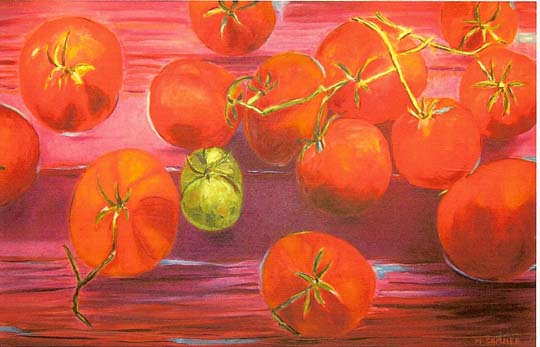
by John Mariani
Photos by Quentin Bacon
BLT MARKET
430 Avenue of the Americas (at 59th Street)
212-521-6125
Laurent Tourondel probably never had in mind opening a place like BLT Market when he was a young cook back in France, working with three-star chefs like Jacques Maximin and the Troisgros Brothers and having made his own reputation in NYC at the haute seafood restaurant Cello a few years back.
But then he also probably never imagined opening the restaurant that made his fortune, BLT Steak, which means "Bistro Laurent Tourondel Steak" and which he debuted in 2004 as a French riff on a traditional American steakhouse and did so with such panache that there's rarely been an empty seat since. It also spawned BLT Fish downtown in 2005, a very commendable turn on both the casual and serious American seafood house.
At that time I began to wonder just how far Tourondel could go with the BLT brand, writing, "There are already plans to open BLT Prime this fall, and that worries me. One can only wonder if next year he'll open BLT Veggie. You can stretch a sauce too thin, and I hope success doesn't translate into multi-units in multi-cities. Time will tell."
Well, now the BLT brand, owned by Tourondel and two partners, is expanding rapidly, with BLT Burger, also in NYC, and branches of BLT Steak in
So I worry. Especially because his newest venture in NYC is a far more expansive concept than the rest. Located in the Ritz-Carlton on
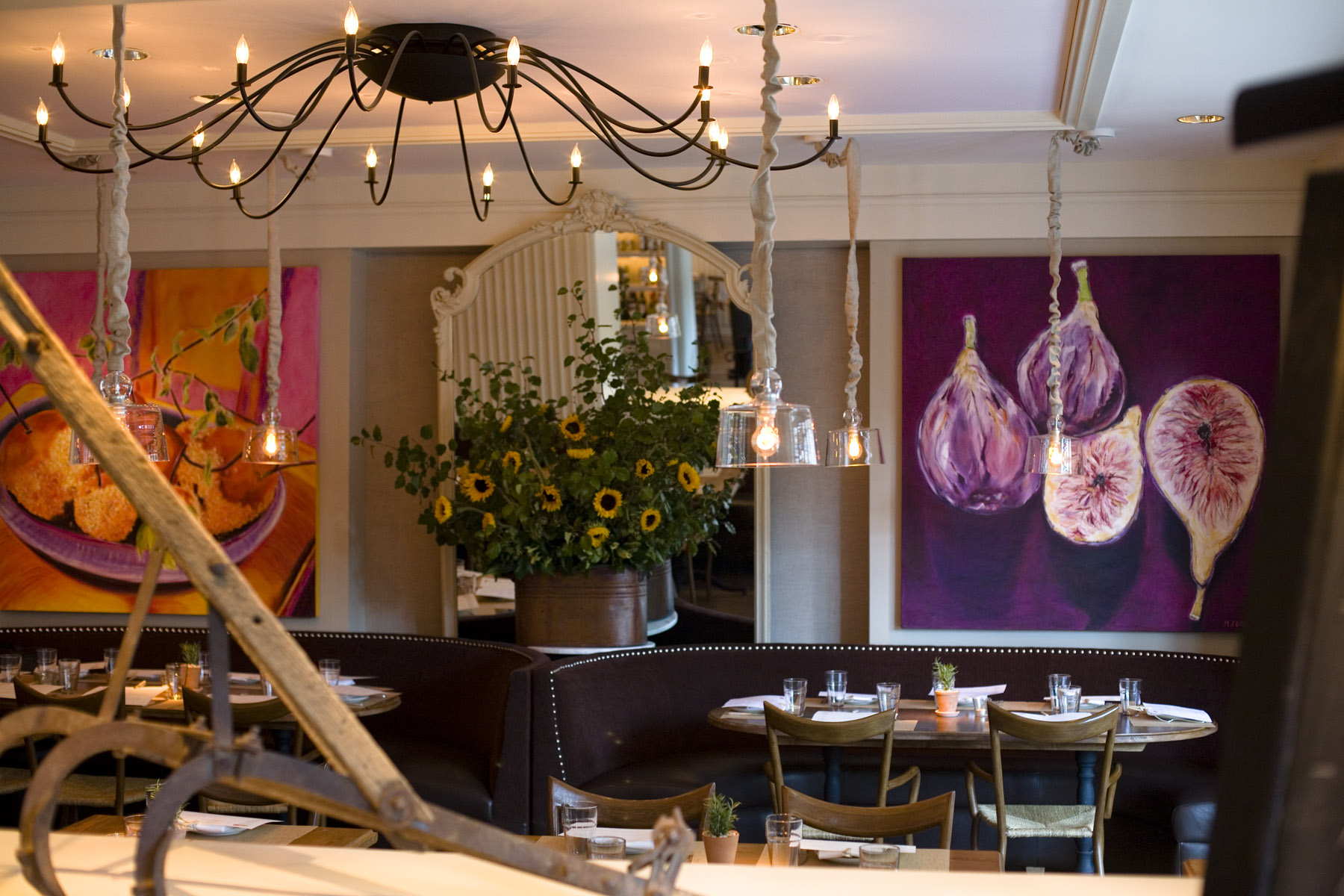 There is no pretense that Tourondel himself
is back there brining the pickles: Chef
de
cuisine David Malbequi is in charge of the kitchen, and he turns out a
very rich menu of old favorites done with considerable flair, and the
size of the menu--six starters, plus soup, pasta, and risotto, and 7
main courses, with nightly specials--is ideal for a place this size.
Down the side of the menu are listed ingredients that are "Peak in
Season," right now salsify, sunchokes, black trumpet mushrooms, black
cod, pomegranates, and much else. Unfortunately his crew has a heavy
hand with salt, which marred the appreciation of those first-rate
ingredients used here.
There is no pretense that Tourondel himself
is back there brining the pickles: Chef
de
cuisine David Malbequi is in charge of the kitchen, and he turns out a
very rich menu of old favorites done with considerable flair, and the
size of the menu--six starters, plus soup, pasta, and risotto, and 7
main courses, with nightly specials--is ideal for a place this size.
Down the side of the menu are listed ingredients that are "Peak in
Season," right now salsify, sunchokes, black trumpet mushrooms, black
cod, pomegranates, and much else. Unfortunately his crew has a heavy
hand with salt, which marred the appreciation of those first-rate
ingredients used here.No one leaves hungry: Start off with some very good charcuterie to go with a loaf of warm bread stuffed with garlic, in a paper sleeve, as they do in New Orleans. You get a sizable slab of seared duck foie gras with a Jurançon grape vinaigrette and quince purée--the acids and sweetness nicely balanced. Raw hamachi with avocado, cilantro purée, and a cucumber and McIntosh apple vinaigrette is a lovely, light rendering, pristinely fresh, while simply steamed jumbo stone crabs ($15 each) came with a lemon mousseline for dipping. Nantucket bay scallops, now hitting their peak, were a little fussed over with caramelized walnuts, watercress, endive, and an assertive blue cheese, and agnolotti filled with duck in a fennel-anise-beurre blanc was good but a little went a long way. There was a lot of flavor in wild mushroom manicotti with a gratin topping and sage brown butter, but wow! was it rich.
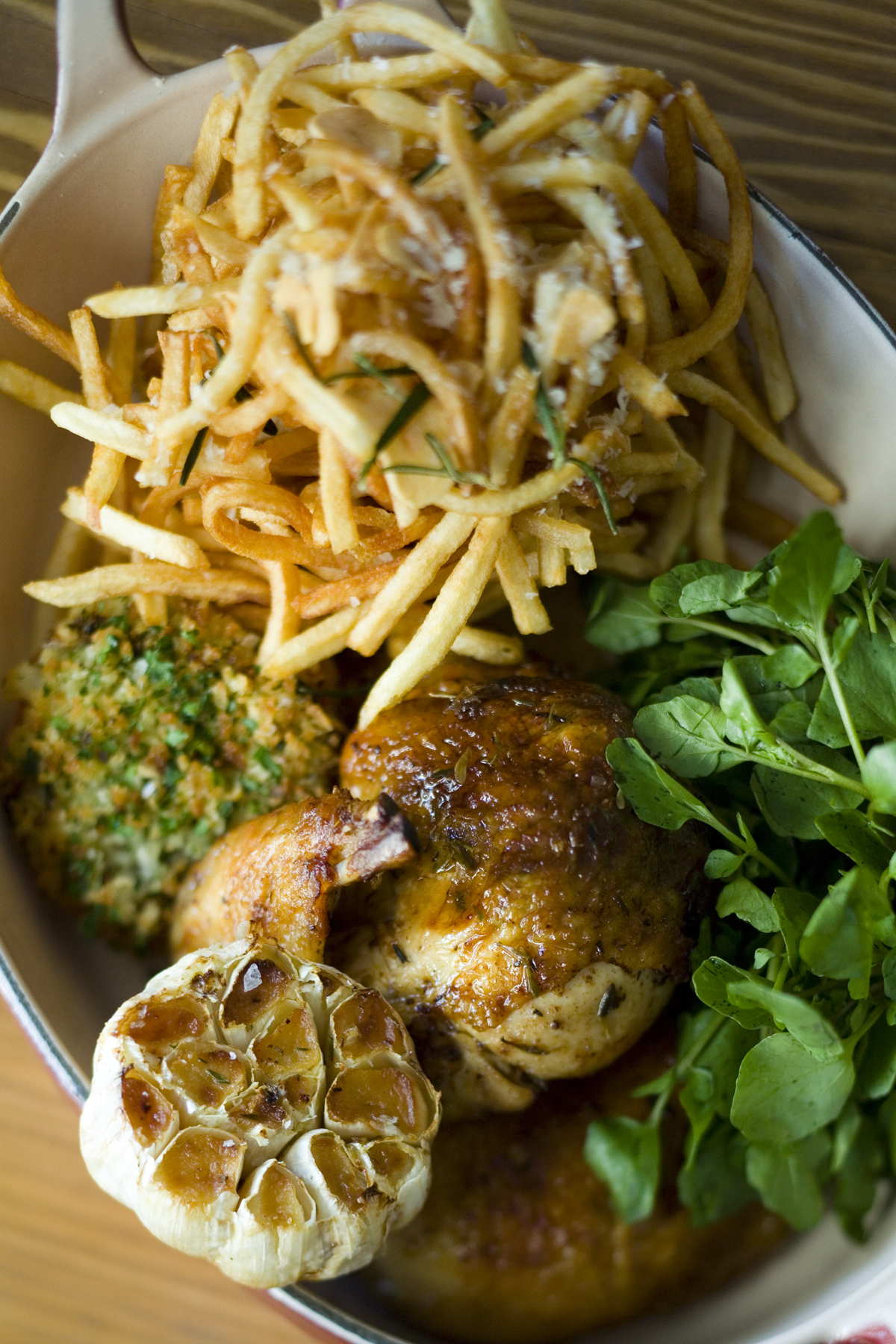
The best of the main courses was a pistachio-crusted loin of excellent, lightly gamy venison, with salsify and Brussels sprouts and some welcome cranberry counterpoints. Also good was a pan-seared red snapper with braised Savoy cabbage and orange-scented polenta. Roast rack of lamb with a porcini-artichoke ragoût and pommes dauphine were acceptably French in style, but two orders of Amish chicken (right) stuffed with too much rosemary and lemon confit were dry and salty, and the shoestring potatoes a little oily.
For dessert there is an old Tourondel favorite--a caramelized crêpe soufflé he made famous at BLT Steak, along with some downright yummy honey crisp apple cake with Calvados caramel. A chestnut floating island was only a tad better than most renditions of this fluffy classic item. They also offer a cheese each night made by a local farmer--but at $14, that's one expensive cheese.
On a Monday evening BLT Market was hopping, with a mixed crowd of New Yorkers and out-of-towners, most in casual clothes, who came to eat seriously and well and very much of the season. If the kitchen holds back on the salt, those wonderful just-arrived ingredients will really shine.
BLT Market is hitting on all cylinders right now, but I only hope that Tourondel pays as much or more attention to this property as he does to expanding others from here to Tipperary.
BLT Market is open daily for breakfast and dinner, Mon.-Sat. for lunch, and Sat. & Sun. for brunch.
Too Much Choice Makes
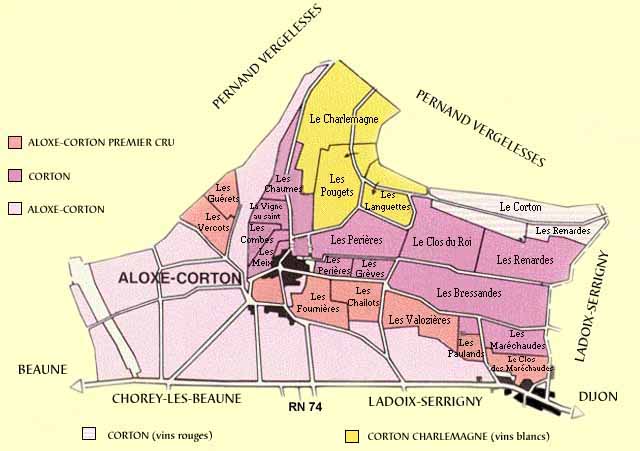 For
a wine with such a high reputation,
there seems to be way too many Corton appellations to make it as
familiar as
other prestigious Burgundies. The Corton region is spread over 715
acres of the
Côte de Beaune and produces a generous 1.5 million bottles a
year, 95 percent of
it red.
For
a wine with such a high reputation,
there seems to be way too many Corton appellations to make it as
familiar as
other prestigious Burgundies. The Corton region is spread over 715
acres of the
Côte de Beaune and produces a generous 1.5 million bottles a
year, 95 percent of
it red.About 480,000 bottles of red are made under the highest Grand Cru appellation—more than one-quarter of all the red grand cru in both the Côte de Nuits and Côte de Beaune--with the rest either Aloxe-Corton Premier Cru or simply Aloxe-Corton. But those Grand Crus reds may come from any of 19 different areas, plots, and vineyards in the region, and, as is the tradition in
“There’s just too much land Corton can come from,” contends Patrick Seré, Vice-President of Dreyfus, Ashby &
If this all seems highly confusing, it is. So the best way to buy Burgundies, and Cortons in particular, is to stay with the best-known producers readily exporting to the world market. These would include names like Bouchard Père et Fils, Joseph Drouhin, Antonin Guyon, Louis Jadot, Louis Latour, Leroy, and Tollot-Beaut, most of which make a range of Corton wines. Connoisseurs might know a few of the top small domaines, like Bonneau du Martray, who is considered one of the greatest Corton producers.
Before and during the lunch I had a chance to sample 22 different Cortons, including a few white Corton Charlemagnes and red Aloxe-Cortons (which proved, at their best, to be as good as higher priced, Grand Cru Corton). The vintages varied, from 1999-2005, as did the prices, from $30 for a Joseph Drouhin Aloxe-Corton 2004 to a white Jacques Prieur Corton Charlemagne 2004 at $240.
One of my favorites was a Joseph Drouhin Corton 2003 ($150), a very elegant, beautifully structured
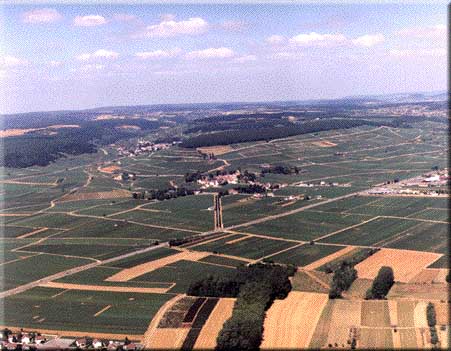
But other wines either showed poorly or gave little indication of maturing further. Some very expensive bottles were surprisingly thin and pale, both in color and flavors, like the Louis Latour Corton Grancey 1999 ($50-$100). A bottle of the same domaine’s 2002 vintage tasted oxidized, and a second bottle was only marginally better but lacked any complexity. Yet the 2005 ($70-$110) was lovely, with moderate body, fine fruit and smooth tannins that made me want to drink it throughout the lunch.
Others I liked a great deal included Louis Jadot's Corton Pougets 2003 ($75-$100), and a beautiful, very lush, aromatic Tollot-Beaut Corton Rouge Grand Cru 2004 ($70-$110), whose fruit is ascendant right now.
At the end, I was not so sure I could make any pronouncements about the consistency of individual vintages or the properties themselves, because they differed even within the same year and terroir. I suppose that’s the beauty of Corton—that it is a wine capable of different styles and character. But with examples easily running above $100 a bottle, I think most winelovers might prefer a sure thing.
John Mariani's weekly wine column appears in Bloomberg Muse News, from which this story was adapted. Bloomberg News covers Culture from art, books, and theater to wine, travel, and food on a daily basis, and some of its articles play of the Saturday Bloomberg Radio and TV.
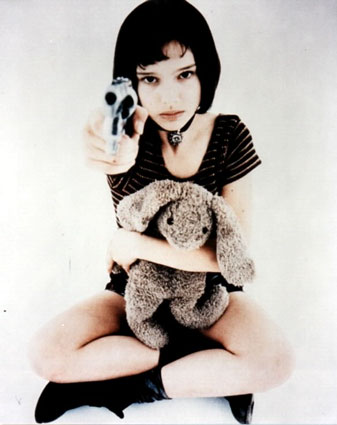
SO
WHO NEEDS AN OSCAR?
NATALIE
PORTMAN has been chosen "Best Veg Celebrity" by VegNews Magazine’s
2007 Veggie Awards.
NOT TO MENTION HOW TO GOUGE A TOURIST
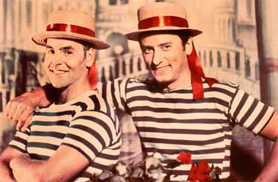
The Hilton Molino Stucky Venice, “responds to the growing demand for unique fitness programs with a distinctively Venetian offering: Gondolier Training. . . .During the training, participants will be coached in the basics of being a gondolier - both physical (rowing with the oars firmly, balancing at the core) and otherwise (the etiquette and proper attitude of a licensed gondolier).”
TO ALL PUBLICISTS: Owing to the amount of material sent to this newsletter regarding Christmas, and New Year's dinners--many of which are only announcements as to price fixed dinners--it is impossible for me to include any but the most unusual of events for those holidays in Quick Bytes. --John Mariani
NEW FEATURE: I am happy to report that the Virtual Gourmet is linking up with two excellent travel sites:
Everett Potter's Travel Report:
Tennis Resorts Online: A Critical Guide to the World's Best Tennis Resorts and Tennis Camps, published by ROGER COX, who has spent more than two decades writing about tennis travel, including a 17-year stretch for Tennis magazine. He has also written for Arthur Frommer's Budget Travel, New York Magazine, Travel & Leisure, Esquire, Money, USTA Magazine, Men's Journal, and The Robb Report. He has authored two books-The World's Best Tennis Vacations (Stephen Greene Press/Viking Penguin, 1990) and The Best Places to Stay in the Rockies (Houghton Mifflin, 1992 & 1994), and the Melbourne (Australia) chapter to the Wall Street Journal Business Guide to Cities of the Pacific Rim (Fodor's Travel Guides, 1991). Click on the logo below to go to the site.
~~~~~~~~~~~~~~~~~~~~~~~~~~~~~~~~~~~~~~~~~~~~~~~~~~~~~~~~~~~~~~~~~~~~~~~~~
MARIANI'S VIRTUAL GOURMET NEWSLETTER is published weekly. Editor/Publisher:
John Mariani. Contributing Writers: Robert Mariani, Naomi
Kooker, Kirsten Skogerson, Edward Brivio, Mort
Hochstein, Suzanne Wright. Contributing
Photographers: Galina Stepanoff-Dargery, Bobby Pirillo. Technical
Advisor: Gerry McLoughlin.
Any of John Mariani's books below
may be ordered from amazon.com by clicking on the cover image.
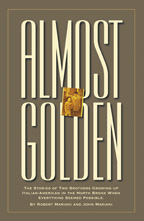 My
newest book, written with my brother Robert Mariani, is a memoir of our
years growing up in the My
newest book, written with my brother Robert Mariani, is a memoir of our
years growing up in the For those of you who don't think of the Robert and I think you'll enjoy this very personal look at our --John Mariani |
 |
 |
 |
 |
 |
 |
copyright John Mariani 2007
